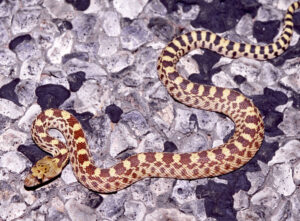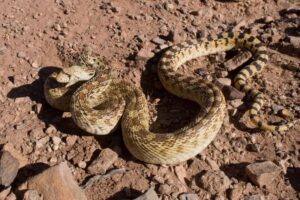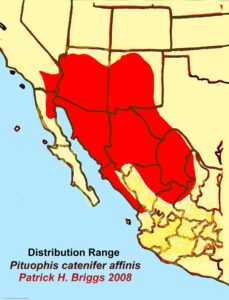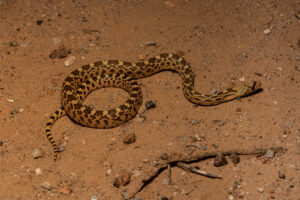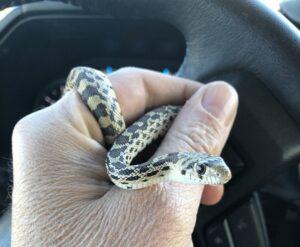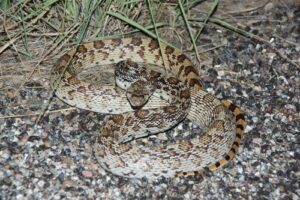Sonoran Gopher Snake (Pituophis catenifer affinis)
Updated on
25/04/2024The Sonoran gopher snake is a subspecies of the gopher snake. The large colubrid is a native of the southwestern United States. The solitary reptile is active during the day, at night in hot weather, and especially at dawn and dusk. The good burrower, swimmer, and climber brumates in winter.
Scientific Classifications
- Suborder:Serpentes
- Family:Colubridae
- Genus:Pituophis
- Species:P. catenifer
- Subspecies:P. c. affinis
Conservation Status
Description
Size
On average, the adults have a total length of 4.17-6 ft (127-183 cm). The maximum recorded total length is 7.68 ft (234 cm).
Color and Appearance
The Sonoran gopher snake has saddle-shaped, reddish-brown dorsal blotches that become dark brown or blackish near and on the tail. The ground color is tan, light brown, or straw. The underside is cream to yellowish, overlaid with dark spots.
Unlike the other Pituophis subspecies, the rostral scale is of equal length and breadth and not elongated. The scales are heavily keeled, and the head is slightly wider than the neck.
Are They Dangerous to Humans
When threatened, the Sonoran gophersnake does quite a few things, sometimes in succession. It quickly crawls away to hide, freezes – making the body firm and kinked up to avoid detection, and strikes to scare away the attacker. Another defense tactic is raising its body and inflating it with air while flattening the head into a triangular shape. This is accompanied by a loud hissing sound and shaking the tail back and forth to produce a buzzing noise.
Sonoran Gopher Snakes at a Glance
Distribution
It is found from central Texas across the southwestern US to southeastern California, Arizona, and the range extends south into the northern states of Mexico.
Habitat
It lives in the Sonoran Desert ecosystem in its range. It can also be found in agricultural land and riparian areas, including those below sea level in the Imperial Valley.
Lifespan
The Sonoran gopher snake lives for 12-15 years.
Predators
It falls prey to coyotes and hawks.
Diet
It consumes small rodents like pocket gophers, mice, etc. Hence its common name. It has tough skin on its nose that helps it burrow into gopher holes and burrows of other rodents to have their food. It also preys on rabbits, moles, birds, their eggs, and nestlings.
Reproduction
Oviparous (lays eggs that hatch outside the body)
After mating in spring, adult females lay clutches of 7-22 eggs each in July or August. The dimension of an egg is 2 in x 1.4 in (51 mm x 35 mm). The hatchlings emerge in the fall and have a total length of 15.5 in (40 cm). The juveniles have more compact and darker patterns than the adults.
Care Sheet
Though the snake is moderately defensive, it can be tamed and turn out to be very gentle.
Size of the Enclosure: The babies can be kept in 10-gallon enclosures, with the size increasing with their age. An adult needs at least a 36” x 18” tank of 40 gallons capacity.
Temperature: The hot side of the cage should be kept at 85°F-88°F and the cool side at 75°F-80°F. The night temperature can drop to 72°F.
Humidity: They need a humidity level of 50-60%. Including a non-porous water bowl in the cage ensures that your pet always has access to clean water.
Substrate: As they love burrowing, you can use a substrate with loose particles like beech wood chips. Other options are aspen wood chips and orchid bark.
Feeding: The babies should be fed one rodent once a week. The girth of the rodent should not exceed that of the snake at its widest point. The same food can be given to adults twice a week.
Source
inaturalist.org, animalia-bio.com, slitherbriggs.webs.com, flickr.com, squarespace-cdn.com, acousticatlas.org

